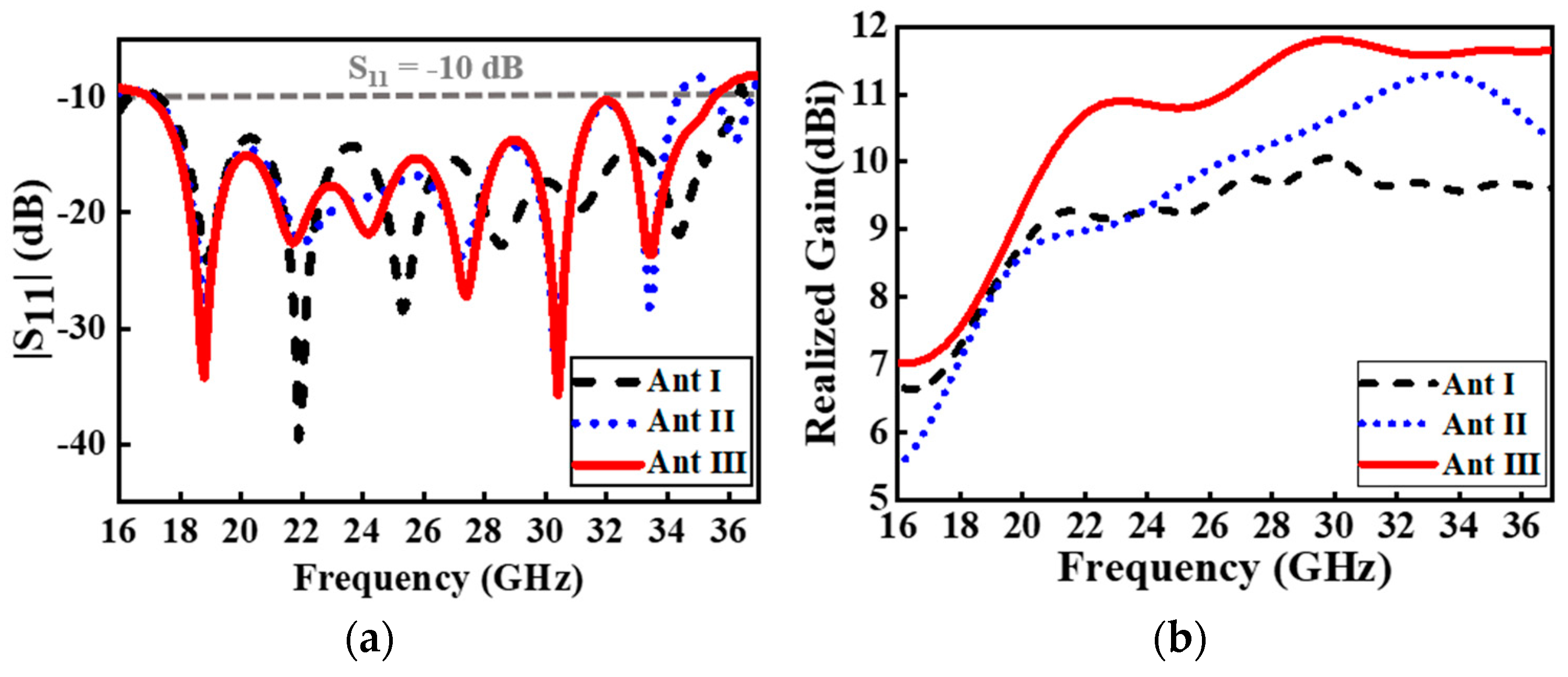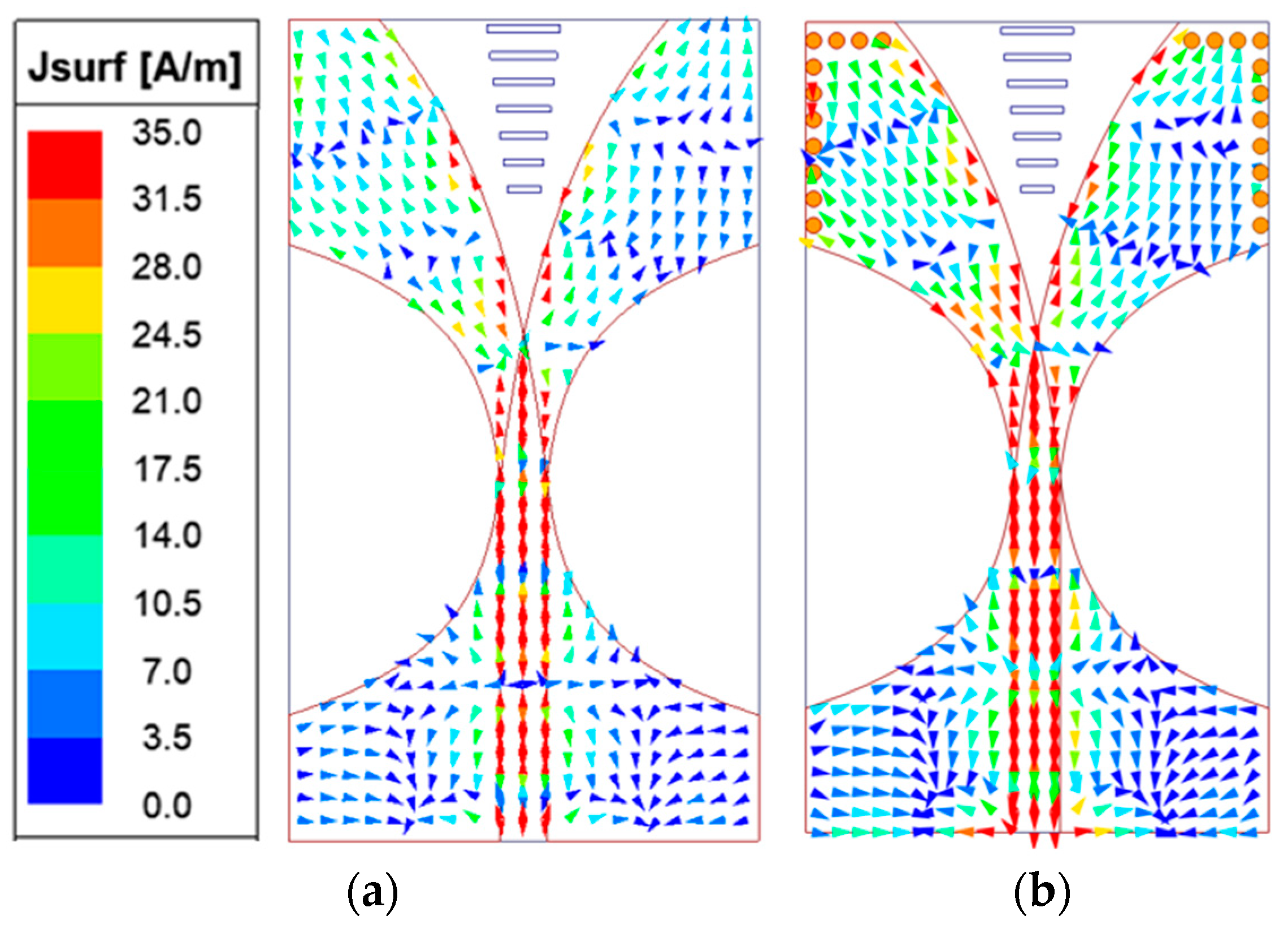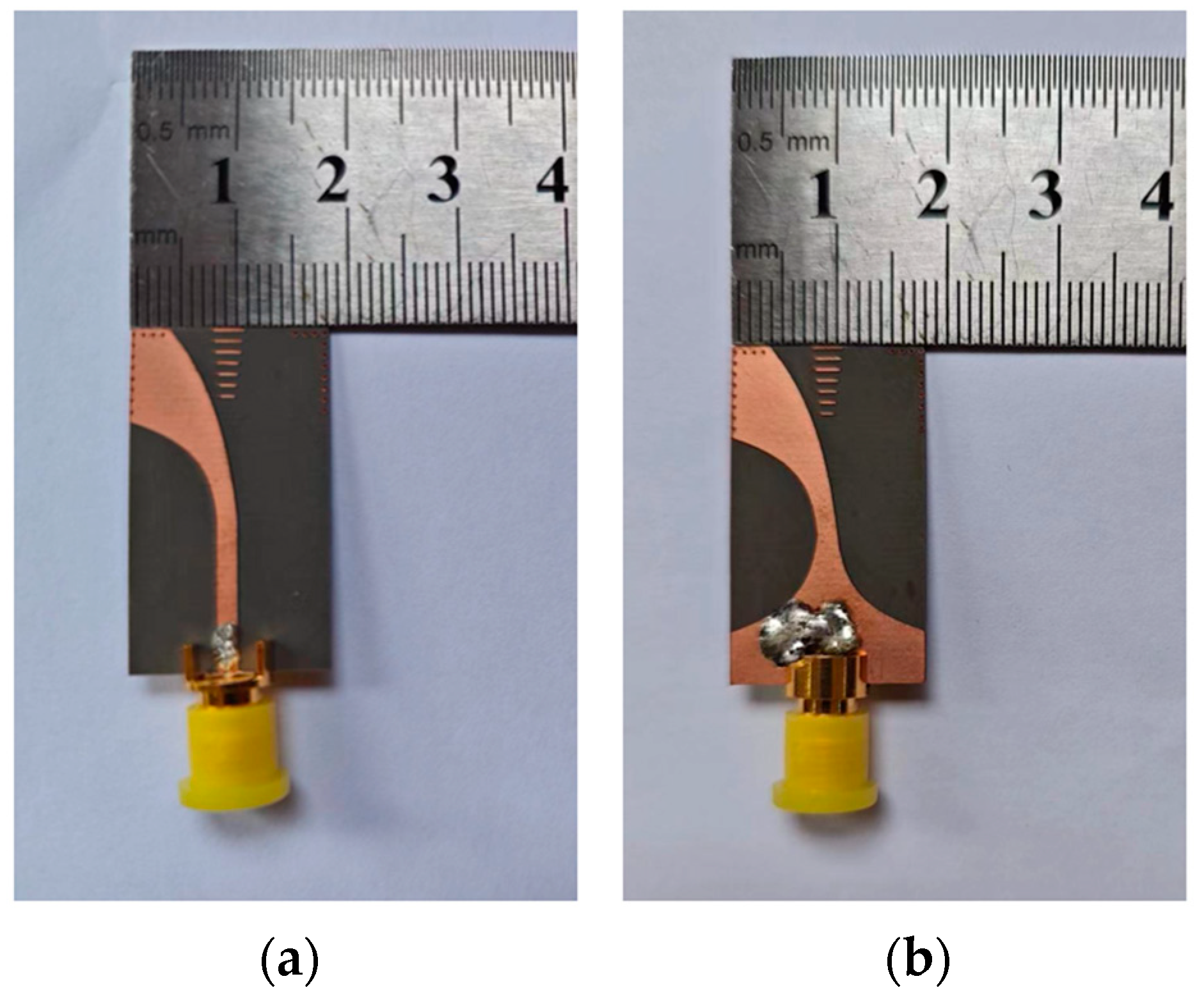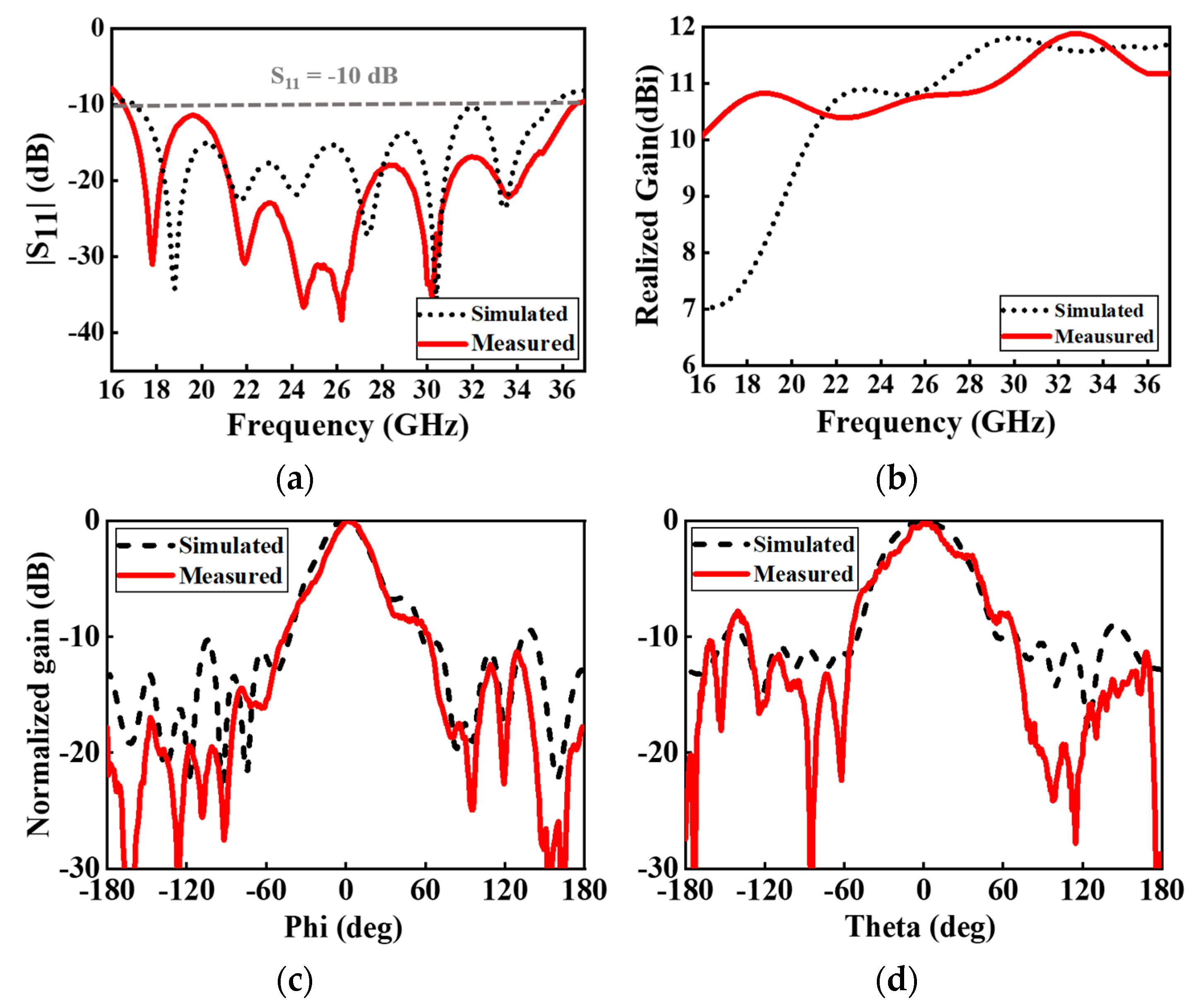A High-Gain Metallic-via-Loaded Antipodal Vivaldi Antenna for Millimeter-Wave Application
Abstract
1. Introduction
2. Geometrics and Antenna Design
3. Discussion of Measurements and Fabrication Results
4. Conclusions
Author Contributions
Funding
Data Availability Statement
Conflicts of Interest
References
- Al-Shammari, B.K.J.; Hburi, I.; Idan, H.R.; Khazaal, H.F. An Overview of mm-Wave Communications for 5G. In Proceedings of the 2021 International Conference on Communication & Information Technology (ICICT), Basrah, Iraq, 5–6 June 2021; pp. 133–139. [Google Scholar]
- Juneja, S.; Pratap, R.; Sharma, R. Study of Two Design Variations of an Antipodal Vivaldi Antenna Working at 28 GHz Millimeter Wave Frequency for 5G Applications. In Proceedings of the 2022 IEEE 2nd Mysore Sub Section International Conference (MysuruCon), Mysuru, India, 16–17 October 2022; pp. 1–5. [Google Scholar]
- Huang, G.-L.; Pang, Z.-Y.; Al-Nuaimi, M.K.T.; Kishk, A.A.; Mahmoud, A. A Broadband and High Aperture Efficiency Multilayer Transmitarray Based on Aperture-Coupled Slot Unit Cells. IEEE Trans. Antennas Propag. 2023, 71, 9633–9642. [Google Scholar] [CrossRef]
- Zhu, S.; Liu, H.; Chen, Z.; Wen, P. A Compact Gain-Enhanced Vivaldi Antenna Array with Suppressed Mutual Coupling for 5G mm-Wave Application. IEEE Antennas Wirel. Propag. Lett. 2018, 17, 776–779. [Google Scholar] [CrossRef]
- Honari, M.M.; Ghaffarian, M.S.; Mirzavand, R. Miniaturized Antipodal Vivaldi Antenna with Improved Bandwidth Using Exponential Strip Arms. Electronics 2021, 10, 83. [Google Scholar] [CrossRef]
- Liu, H.; Yang, W.; Zhang, A.; Zhu, S.; Wang, Z.; Huang, T. A Miniaturized Gain-Enhanced Antipodal Vivaldi Antenna and Its Array for 5G Communication Applications. IEEE Access 2018, 6, 76282–76288. [Google Scholar] [CrossRef]
- Parveen, F.; Wahid, P. Design of Miniaturized Antipodal Vivaldi Antennas for Wideband Microwave Imaging of the Head. Electronics 2022, 11, 2258. [Google Scholar] [CrossRef]
- Umar, S.M.; Khan, W.-U.-R.; Ullah, S.; Ahmad, F. Gain Enhancement Technique in Vivaldi Antenna For 5G Communication. In Proceedings of the 2019 2nd International Conference on Computing, Mathematics and Engineering Technologies (iCoMET), Sukkur, Pakistan, 30–31 January 2019; pp. 1–4. [Google Scholar]
- Wan, F.; Chen, J.; Li, B. A Novel Ultra-wideband Antipodal Vivaldi Antenna with Trapezoidal Dielectric. Microw. Opt. Technol. Lett. 2018, 60, 449–455. [Google Scholar] [CrossRef]
- Amiri, M.; Tofigh, F.; Ghafoorzadeh-Yazdi, A.; Abolhasan, M. Exponential Antipodal Vivaldi Antenna with Exponential Dielectric Lens. IEEE Antennas Wirel. Propag. Lett. 2017, 16, 1792–1795. [Google Scholar] [CrossRef]
- Cicchetti, R.; Cicchetti, V.; Faraone, A.; Testa, O. A Class of Lightweight Spherical-Axicon Dielectric Lenses for High Gain Wideband Antennas. IEEE Access 2021, 9, 151873–151887. [Google Scholar] [CrossRef]
- Shi, X.; Cao, Y.; Hu, Y.; Luo, X.; Yang, H.; Ye, L.H. A High-Gain Antipodal Vivaldi Antenna with Director and Metamaterial at 1–28 GHz. IEEE Antennas Wirel. Propag. Lett. 2021, 20, 2432–2436. [Google Scholar] [CrossRef]
- Li, X.; Zhou, H.; Gao, Z.; Wang, H.; Lv, G. Metamaterial Slabs Covered UWB Antipodal Vivaldi Antenna. IEEE Antennas Wirel. Propag. Lett. 2017, 16, 2943–2946. [Google Scholar] [CrossRef]
- Liu, L.; Jiang, Y.; Hu, Y.; Jiang, D.; Zhu, L. Wideband Millimeter-Wave Endfire Antenna Based on Symmetrical Spoof Surface Plasmon Polaritons. IEEE Trans. Antennas Propag. 2021, 69, 7386–7393. [Google Scholar] [CrossRef]
- Zhang, X.-F.; Sun, W.-J.; Chen, J.-X. Millimeter-Wave ATS Antenna with Wideband-Enhanced Endfire Gain Based on Coplanar Plasmonic Structures. IEEE Antennas Wirel. Propag. Lett. 2019, 18, 826–830. [Google Scholar] [CrossRef]
- Gibson, P.J. The Vivaldi Aerial. In Proceedings of the 1979 9th European Microwave Conference, Brighton, UK, 17–20 September 1979; pp. 101–105. [Google Scholar]
- Sandhana Mahalingam, M.; Pandeeswari, R.; Ko, S.; Kouki, A.B. A Compact Balanced Antipodal Vivaldi Antenna with Improved Phase Center Stability for Imaging and Ultrawideband Localization Applications. AEU-Int. J. Electron. Commun. 2023, 170, 154844. [Google Scholar]
- Li, J.; He, H.; Xiong, S.; Feng, G.; Wang, Y. A Novel High-gain Antipodal Vivaldi Antenna for 5G MM-wave Applications. AEU-Int. J. Electron. Commun. 2024, 177, 155160. [Google Scholar] [CrossRef]
- Thaiwirot, W.; Kamoldej, D.; Detchporn, P.; Thongdit, R.; Tangwachirapan, S. Design of Ultra-Wideband and Constant Gain Antipodal Vivaldi Antenna with Corrugations. In Proceedings of the 2022 International Electrical Engineering Congress (iEECON2022), Khon Kaen, Thailand, 9–11 March 2022. [Google Scholar]
- Singh, M.; Parihar, M.S. Gain Improvement of Vivaldi MIMO Antenna with Pattern Diversity Using Bi-Axial Anisotropic Metasurface for Millimeter-Wave Band Application. IEEE Antennas Wirel. Propag. Lett. 2023, 22, 621–625. [Google Scholar] [CrossRef]
- Azari, A.; Skrivervik, A.; Aliakbarian, H.; Sadeghzadeh, R.A. A Super Wideband Dual-Polarized Vivaldi Antenna for 5G mmWave Applications. IEEE Access 2023, 11, 80761–80768. [Google Scholar] [CrossRef]
- Zhu, S.; Liu, H.; Wen, P. A New Method for Achieving Miniaturization and Gain Enhancement of Vivaldi Antenna Array Based on Anisotropic Metasurface. IEEE Trans. Antennas Propag. 2019, 67, 1952–1956. [Google Scholar] [CrossRef]
- Qi, H.; Liu, H. Wideband high-gain filtering Vivaldi antenna design based on MS and herringbone SSPP structure. IEEE Antennas Wirel. Propag. Lett. 2023, 22, 1798–1802. [Google Scholar] [CrossRef]






| Parameters | Value (mm) | Parameters | Value (mm) | Parameters | Value (mm) |
|---|---|---|---|---|---|
| L1 | 30.7 | Wd | 0.25 | ∆X | 0.125 |
| L2 | 17.6 | D1 | 1 | W3 | 10.8 |
| W1 | 17.6 | D2 | 0.875 | Ld | 2.975 |
| W2 | 1.75 | D3 | 1 | R1 | 0.3 |
| a1 | 2 | a2 | 0.6 |
| Ref. | Bandwidth (GHz) | Gain (dBi) | Dimension () | Relative Bandwidth |
|---|---|---|---|---|
| [20] | 24–32 | 8.2–10.2 | 3.36 × 3.36 × 0.07 | 28.57% |
| [21] | 22.5–45 | 5.5–8.5 | 1.35 × 0.62 × 0.03 | 67.56% |
| [22] | 24.15–28.5 | 9.35–12 | 5.27 × 2.51 × 0.07 | 16.52% |
| [23] | 15–27 | 8–10 | 2.65 × 0.98 × 0.035 | 57.14% |
| Prop. | 16.9–35.6 | 9.8–11.9 | 1.54 × 2.69 × 0.07 | 71.24% |
Disclaimer/Publisher’s Note: The statements, opinions and data contained in all publications are solely those of the individual author(s) and contributor(s) and not of MDPI and/or the editor(s). MDPI and/or the editor(s) disclaim responsibility for any injury to people or property resulting from any ideas, methods, instructions or products referred to in the content. |
© 2024 by the authors. Licensee MDPI, Basel, Switzerland. This article is an open access article distributed under the terms and conditions of the Creative Commons Attribution (CC BY) license (https://creativecommons.org/licenses/by/4.0/).
Share and Cite
Li, J.; Huang, J.; He, H.; Wang, Y. A High-Gain Metallic-via-Loaded Antipodal Vivaldi Antenna for Millimeter-Wave Application. Electronics 2024, 13, 1898. https://doi.org/10.3390/electronics13101898
Li J, Huang J, He H, Wang Y. A High-Gain Metallic-via-Loaded Antipodal Vivaldi Antenna for Millimeter-Wave Application. Electronics. 2024; 13(10):1898. https://doi.org/10.3390/electronics13101898
Chicago/Turabian StyleLi, Jun, Junjie Huang, Hongli He, and Yanjie Wang. 2024. "A High-Gain Metallic-via-Loaded Antipodal Vivaldi Antenna for Millimeter-Wave Application" Electronics 13, no. 10: 1898. https://doi.org/10.3390/electronics13101898
APA StyleLi, J., Huang, J., He, H., & Wang, Y. (2024). A High-Gain Metallic-via-Loaded Antipodal Vivaldi Antenna for Millimeter-Wave Application. Electronics, 13(10), 1898. https://doi.org/10.3390/electronics13101898






